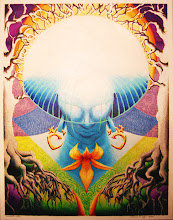
So... normally I would not recommend some little doo dad to help you sit/ meditate more effectively but this deserves some serious consideration my friends.
I was at a local organic baby festival and they had a demo booth for these amazing lower lumbar support devices/ chairs. I had a noticeable difference in overall well being after just a couple of minutes using one. It supports your hips and back in a way that is ergo dynamic and for those of us who sit frequently, we know how our bodies can disagree and distract us. I purchased the "Back Up" but all of the products do the same thing. On the package it says "Designed by meditators for life"... I believe em.
http://www.nadachair.com
Here is what the site has to say:
Benefits of Use
Watch the animations on the left to better understand how Nada-Chair products will benefit you. The first shows your spine as a naturally curving, flexible stack of bones called vertebrae. Separating the vertebrae are soft-core, donut-shaped discs. When you sit for a time, muscles slack, causing you to slouch. Slouching unevenly compresses the lumbar discs as shown in the second animation. The vertebrae bite one side of the lumbar disc causing the soft core to bulge against the back wall. This causes back pain and over time, leads to herniation, ruptures or other disc malformations. Slouching is a serious back problem that spirals you into further back pain cycles. (Click here for a more comprehensive medical description of how Nada-Chair breaks the back pain cycle.)
The Nada-Chair promotes good posture which, in turn, reverses the back pain cycle. It comfortably cradles the low back and follows the body with every movement, making it is impossible to slouch. Since you can't slouch, your discs are protected. Users report instant relief of low back, neck and shoulder pain associated with slouching. Good posture naturally allows deeper breathing so you feel refreshed with a greater sense of well-being. Better health, in turn, means fewer doctor visits. You save time and money (not least on prescription pain-killers). People admire good posture. (When did you last stop to admire a slouch?) Originally designed by meditators who found they can often sit longer more comfortably, those at computers also find they focus better when attention isn't sucked to nagging back pain. In short, Nada-Chair back slings are designed to let you sit comfortably for hours with effortless good posture.
PROBLEM - Chairs Don't Work
"All my life my legs have been banged up
by chairs that I've designed"
- Frank Lloyd Wright
Slouching is a universal back problem that can lead to permanent and painful deformations of the spine. Not only do chairs NOT solve this problem, most often they make it worse! Why? Chairs are passive mechanisms that cannot provide adequate support at the low back where it is essential for healthy, comfortable and upright posture. So-called "ergonomic" chairs promise lumbar support, but they can't deliver. Serving only as props for slouched spines, these chairs make back problems worse. Why else do so many complain of low back pain and associated neck and shoulder stress caused by slouching? Bottomline: chairs don't work.
SOLUTION - Wear Your Chair
The ideal chair that moves with the body "just as a glove moves with the hand that wears it."
- Emilio Ambasz
The Nada-Chair is the chair that you wear. This slouch-busting sling lets you sit comfortably for hours with effortless good posture. When you sit forward, the back support follows. Since the Nada-Chair follows your body with every move, you constantly enjoy firm, adjustable and dynamic support hugging your low back. "The Nada-Chair acts like an extra muscle that never tires," explains Arthur White, MD. By using the knees to stabilize the pelvis, muscles are relieved of their isometric tasks. The pelvis becomes a stable pedestal on which the spine can effortlessly rest with natural curves restored.
Be well!









